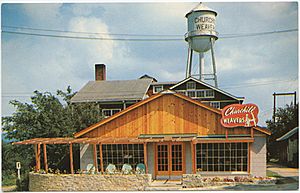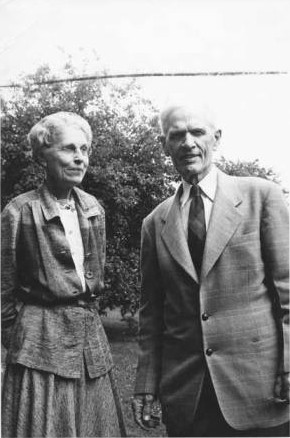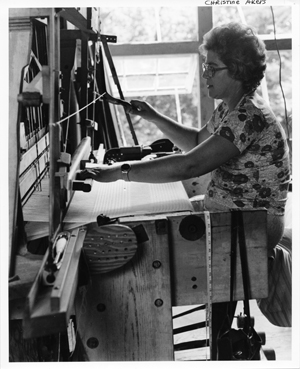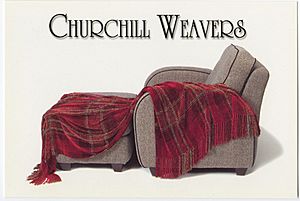Churchill Weavers facts for kids
Churchill Weavers was a special company that made beautiful handwoven items. It operated in Berea, Kentucky, from 1922 to 2007. This area, in the Appalachia, is famous for its handmade crafts. Churchill Weavers was the first company to make many handwoven products for people all over the country.
Contents
Meet the Founders
David Carroll (D.C.) Churchill (1873 – 1969) and Eleanor Franzen Churchill (1888 – 1981) started Churchill Weavers. They wanted to create jobs for people in Appalachia. Before this, they were not business owners. But they knew a lot about weaving. They combined skills in engineering, design, and business.
Their Work in India
D.C. Churchill was from Oberlin, Ohio. He studied engineering at Massachusetts Institute of Technology. He then went to India as a missionary. There, he worked as an engineer. He helped with industrial projects.
Eleanor was from Connecticut. She graduated from Wellesley College. She was teaching in India when she met D.C. They married in 1914.
In the early 1900s, handweaving was a big industry in India. But individual weavers struggled to compete with machines. D.C. studied how people wove cloth. He invented a new type of loom. This loom helped weavers make twice as much cloth. By 1911, his improvements allowed 36 people to do the work of 200. This helped them compete with factories.
The British government in India gave D.C. grants. He used them to study weaving methods worldwide. This happened when he traveled to and from the United States. They decided to stay in the U.S. in 1917 because of World War I.
Starting the Company in Kentucky
When they returned to the U.S. in 1917, the Churchills lived in Oberlin, Ohio. D.C. worked on inventions for the war. One invention was the first working retractable airplane landing gear.
In 1920, the family moved to Berea, Kentucky. D.C.'s friend, William J. Hutchins, invited him to teach physics at Berea College. D.C. also planned to start his own business. He wanted to design and sell looms.
D.C. left the college in 1922. He wanted to start his own business full-time. The Churchills decided to stay in Berea. They started their company to make handwoven goods.
D.C. used his engineering and business skills. He made the weaving process more efficient. He built special looms. He also created new tools to make work easier for weavers. Eleanor used her weaving experience and design skills. She also helped with marketing and managing the business.
What Made Them Special?
Churchill Weavers was different from other weaving businesses. They hired both women and men. By the late 1940s, they employed up to 150 people. Other weaving places mostly hired women.
D.C. made the work process very organized. Workers came to a central building. Each person had a specific task. In other areas, one weaver did all the steps alone at home.
Churchill Weavers made many different items. They made baby blankets and couch throws, which were very popular. They also made clothing. Other local weavers usually only made small items like placemats.
Eleanor helped the company sell its products all over the country. They sold items in big cities like New York and Chicago. She used special ways to market their goods. This included demonstrations in stores and professional models in their catalogs.
Amazing Products
Besides clothing, throws, and baby blankets, Churchill Weavers also made special fabrics. They took on unique projects for other companies.
In 1960, B.F. Goodrich asked them to make fabric for space travel. Churchill Weavers made 50 yards of special heat-resistant fabric. This fabric was considered for astronaut suits in the Mercury Mission.
In the 1970s and 1980s, artist Gerhardt Knodel asked them to make fabric for his art. They created textiles for large art installations. These included "Free Fall" in Detroit and "Sky Ribbon" in Oklahoma City.
The Churchill family ran the company for over 50 years. In 1973, Eleanor asked Lila and Richard Bellando to take over. Richard worked for the Kentucky Guild of Artists and Craftsmen. Lila had studied art. The Bellandos ran the business until 1996. They sold it to Crown Craft in Georgia. They hoped this would bring more resources and benefits for employees. Lila continued to manage the business for 11 more years.
Churchill Weavers still makes its unique handwoven items today. It has continued production since being sold to a company in Indiana in 2007.
Historic Recognition
In 2007, the Kentucky Historical Society received the Churchill Weavers' collection. This collection shows almost every product and pattern the company ever made. It has over 30,000 fabric samples.
The collection also includes design books, sales brochures, and business records. There are original photographs and old advertising signs. It even has two antique looms that D.C. Churchill designed. These items help tell the company's history.
In 2014, the Churchill Weavers building in Berea was added to the National Register of Historic Places. It was recognized for its role in the local Arts and Crafts movement. It was also honored because of its connection to David Carroll Churchill.





